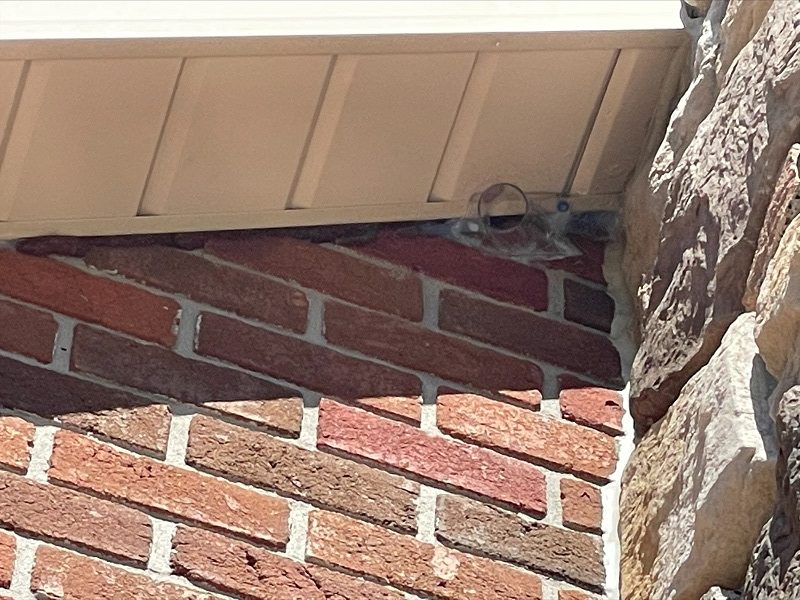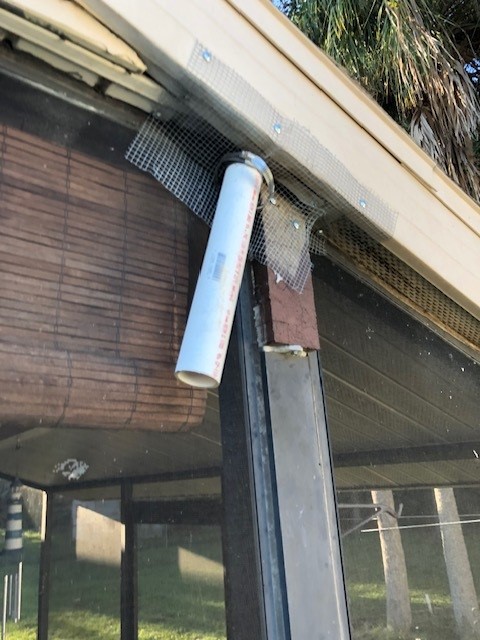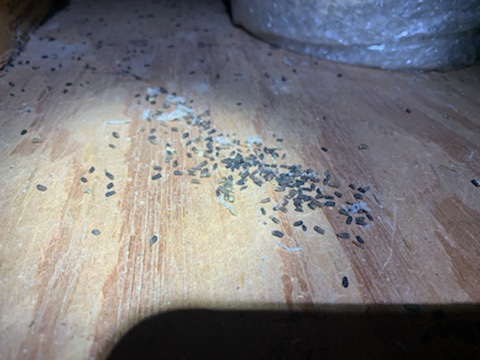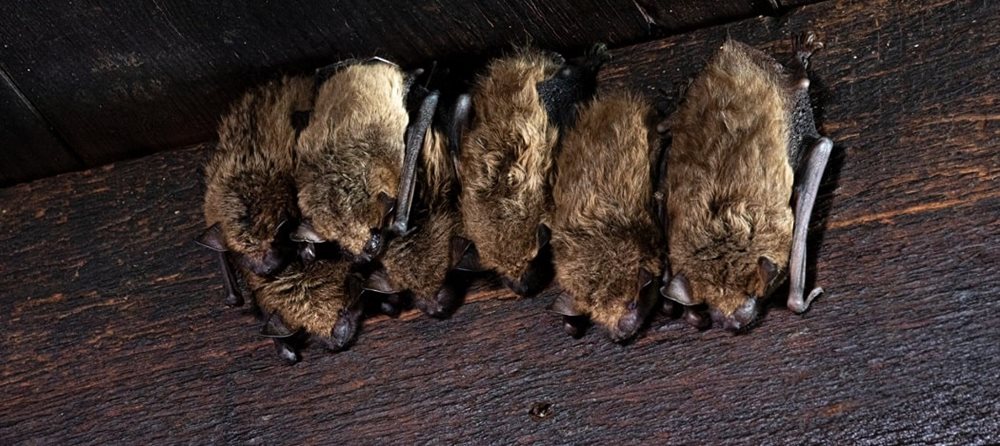
Bats are amazing animals. Without them, our ecosystem would be out of balance. Every bat eats thousands of insects nightly. During the day, bats roost, allowing food to digest. This allows them to lower their metabolisms and conserve energy while they sleep.
Although bats are incredible and have earned their spot as protected animals at the state and federal levels, you don’t want a bat in your home. Bats tend to roost in unoccupied areas of your home like attics, wall voids, under eaves and siding, or inside vents.
It is much more likely to find bats in houses when females are looking for safe places to give birth. Homeowners in colder climates can experience hibernating bats in the attic during winter.
A single bat in the house can end up in the living areas. Either a bat flies through an open window or comes from the attic or wall. If there is a bat in the living space of your home, do not touch it with your bare hands! Make sure all people and pets are out of the room. Close the room off and open a window.
It is exceedingly rare for bats to bite you, but it can be difficult to find a bat bite spot. If someone has been in the same room with a bat, it is prudent to seek medical attention or contact the local health department.
Have bats in the house?
Find a Critter Control near you
How Do Bats Get in the House?
Bats can squeeze through a hole smaller than an inch in diameter. If you see a hole the size of a dime, a bat can use it. What humans may see as a small crack, tear, rip, or break in a building, bats see as an entryway.
Why Do Bats Enter a House?
Bats search for dark, warm spaces with beams or boards on which they can hang upside down during daytime hours. The small cracks and holes around your home allow heat to escape. Bats feel even the slightest bit of heat and follow it inside.
Bats are not able to create an entry point. They aren’t strong enough to do so. They have clever ways of getting indoors, however. As bats fly at night, scooping insects into their mouths and wings, they search for places to roost. As they pass by your home, barn, or shed, they use temperatures to determine where to stay.
It can be challenging to find bat entry points due to their small size. Bats stain the arears around entry points. The stains are from the oils on their fur. The rub marks are yellow-brown to a dark brown or blackish color and can appear glossy. The accumulation of guano in gutters or shingles is another sign of a bat entry point. Some may be in locations you cannot access physically or see just by looking. Therefore, hiring an expert is recommended.
If you find a bat entry point, you can test if it is actively used. Put a piece of cardboard over the hole during the day. If the cardboard has been moved, you likely have a bat. Do not seal the hole until you are sure no bats are in the attic.
Typical Bat Entry Holes
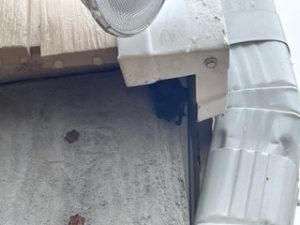
To understand how bats get into a house or how bats get into an attic, you must learn more about building structures. The outside of your home is a barrier to the inside. A break in that barrier allows a bat indoors. Below is a list of places to check for entry points on your property:
Attic Vents
The most common way bats enter your home is through broken attic vents or screens.
Soffits
Soffits are the materials that connect your home’s exterior walls to the planks that hang underneath your eaves. Without soffits, the rafters and beams of your home would be open and exposed. Soffits may occasionally detach in small areas, or wildlife such as woodpeckers and squirrels may break or tear them. This gives a bat just enough space to enter your home.
Fascia Boards
Fascia boards are bands or strips of materials. They serve many purposes, including holding gutters in place and closing off the ends of rafters. They are usually wood strips strong enough for adhering gutters, soffits, and roofing materials. Improper installation or damage due to the elements can leave small openings that bats may enter.
Ridge Vents
Roofs with shingles will have ridge vents along the roof’s peak. The ridge vent allows heat and humidity to exit the house. This heat will attract bats looking for a warm place to roost. If the vent is damaged or cracked, bats will use it as an entry point.
Gable Vents
Gable vents are decorative, allowing air to flow into the attic to cool it down when the temperatures are warm. Homeowners can adjust gable vents based on how much air they want to enter the home. Open vents provide the perfect entry point for bats and other wildlife.
Roof Returns or Eaves
Decorative materials may be used during the building process to attach a roof to the side walls of the home. The construction of these materials as well as the condition of returns may determine how well they hold up to weather conditions. Poor construction can leave entry points for bats.
Siding
Siding, whether wall panels or corners, can be damaged by weather over time or by a random rock thrown by a lawn mower. Nuisance wildlife may also cause damage. If it is not installed correctly, wall panels can buckle. Any of these scenarios give bats the perfect opportunity to use your home as a roost.
The Most Common Places to Find Bats in the House
Below are examples of where you may find bats in homes.
Bats in Attics
Bats like to roost in attics because they are warm, dry, empty spaces that allow them to sleep uninterrupted during the day. They make perfect nesting areas for bats during the maternity season, anytime between late Spring and early Fall, when mothers deliver and raise their pups. Some bats prefer wood framing when roosting, as they may resemble trees.
Signs of bats in attics include piles of guano or feces in areas where they roost. They may also leave their guano at the places where they enter your attic. It may appear as staining on the outside of your home. The insulation in your attic is another place where you will find guano and urine stains. Because their guano and urine contain toxic acids, you may find your floors and walls showing erosion.
A strong ammonia smell and noises in the attic like squeaks or chirps are other signs of bat life.
Bats in Chimneys
Chimneys offer a comfortable place to roost since the bricks surrounding them hold heat inside. Bats must choose sites that help them regulate their body temperature. Chimneys are quiet, easily accessible, and dark. Bats can squeeze through a hole 3/8 of an inch or larger, making some chimney caps useless. Cracks in mortar joints can also offer entry points for these animals.
Signs of bats in chimneys include stains from guano and urine on roof shingles and anywhere inside your fireplace, including at the base when the flue is not shut correctly. If bats are in your chimney, you may hear high-pitched squeaking, wings flapping, and smell an odor like ammonia. While the ammonia odor is always present, the noises bats make will typically be at dusk and night when they are most active.
Bats in Walls
Bats living in your walls can mimic the sounds a mouse makes when inside your walls. They squeak and chirp. The difference is that bats make a fluttering sound instead of scurrying. Liquids quickly deteriorate drywall, including bat urine. You may see urine stains, bubbles, and soft spots that signal bats living on the other side.
Bats get into your home’s walls through pipes that are open outside and lead inside. They may find wall cavities that connect to the attic. A small hole in the exterior of your home may not look like much, but as the weather degrades it, the area can become an access point for bats. Wall cavities are warm, dry, dark spaces perfect for roosting and for maternal bats.
Bats on Roofs
Home roofs offer many roosting spots for bats, including eaves, soffits, gable vents, and dormers. The spaces behind shingles, tiles, siding, and gutters and every place where the roof changes angles are other places bats will inhabit. These spaces may not be the driest or warmest, but they are still covered, dark, and easily accessible.
Signs of bats on a roof are like the signs of bats in other places. Guano piles, urine stains, odors, and in many cases, you can watch bats at dusk start flying around. Outdoor lighting attracts insects; you can watch bats swoop in and grab them for their evening meal at any time during the night.
Bats in Living Spaces
Bats avoid the living spaces of homeowners whenever possible. They do not want human encounters. Occasionally a bat may accidentally fly into your living space through an open window or door. If you see a bat flying around your home, it is not there to harm you. It is searching for a way out. You must remain calm and help it find its way back outdoors.
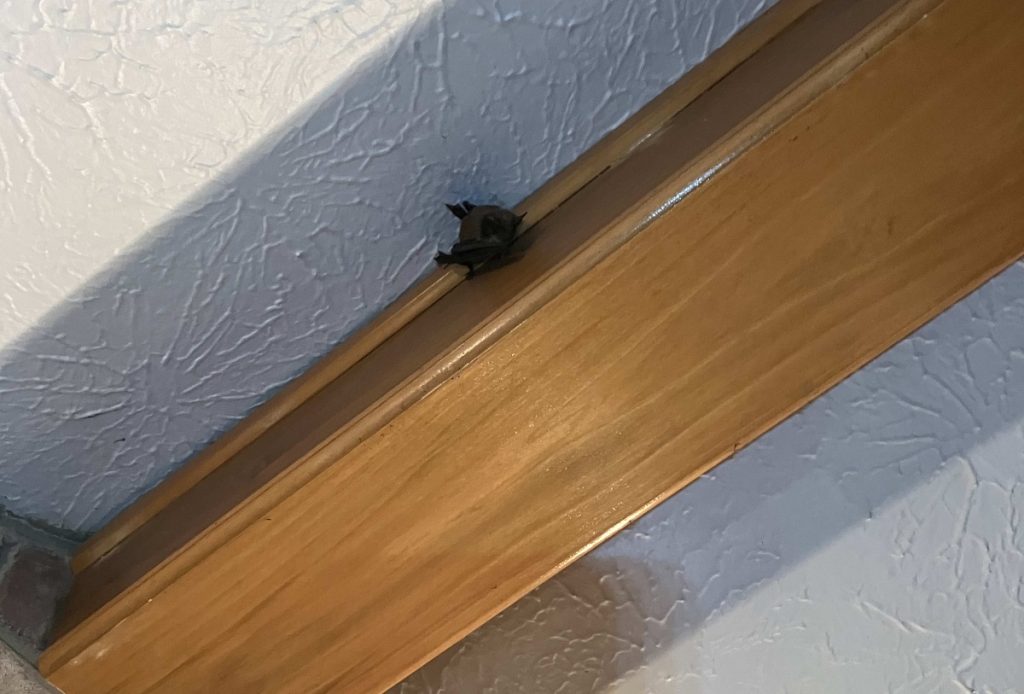
Photo care of Critter Control of Indianapolis
When removing it, you want to ensure safety for you, your family, and the bat. Ask everyone to leave the area where the bat is and leave a door or window open so it can fly out. Give it enough time to exit. If it stays, you can reenter the room and try the following:
- Throw a blanket over the bat.
- Capture it in a bowl with a lid.
- Wearing thick gloves, grab the bat.
- Use a butterfly net.
Do not touch a bat with your bare hands. While rare, they can carry rabies and other diseases and may become aggressive if threatened.
What To Do With a Caught Bat
Do not kill the bat. Most bats are legally protected species due to endangerment, and some species face extinction. Plus, bats are an essential part of our ecosystem.
Before releasing it, seal the opening through which it entered. You may want to contact your local Department of Wildlife or a wildlife operator to see if testing the bat for rabies is required. If so, keep the bat in its container during delivery to the laboratory.
If you are given permission to release the bat but end up capturing it before dusk, you may want to leave it in a dark container and release it later when it is dark outside.
Signs of Bats in the House
Unless you have a colony of bats roosting in your attic making noise or flying in and out of your home, you may have to look for signs commonly left behind by bats. For example, bat guano, or droppings, is easy to spot.
Bat guano is usually black or brown, and because it contains uric acid, it stains any material it lands on. You may see guano streaks running down siding or wood on the sides of homes or buildings. Even while bats are roosting, their guano runs down their body and into a pile below. The piles can get quite large, making them very noticeable. Disturbing these piles of guano can expose people to the risk of histoplasmosis.
Seeing guano directly on the ground signifies that bats are roosting above. Look around windowsills, voids in ceilings and rafters, and structural beams.
Bats are small and they can pack themselves into tiny spaces when they roost. They can go unnoticed by someone with little experience. Calling a wildlife control operator for an inspection takes the guesswork out of locating bats. Experts can also show you exactly how and why bats choose your property.
What to Know About Bat Removal
While the recommendation is to seek help from a wildlife expert trained in removing bats from homes, homeowners often try several methods of getting rid of bats first. Some use scare tactics, like playing loud music in their roost area or shooing them out with a stick or broom. Some may try to catch them with their bare hands. None of these methods are effective and can be dangerous.
It’s important to note that you cannot legally remove bats during the maternity season. The pups must be able to fly out independently before removing them is allowed. The best way to get rid of bats in homes is by using a bat valve and implementing exclusion methods.
At Critter Control, we understand the laws and regulations you must follow, like the following:
- Bats cannot be disturbed during hibernation.
- Bats cannot be removed or harassed during the mating season.
- Pups must be able to fly out on their own.
- Local regulations may require testing for diseases.
Bat Valves and Exclusions

Bat valves are one-way tubes with a narrower side on one end. Valves allow bats to fly out of your home, but their entry is closed when they try to return. Once the bats are out, you must focus on various exclusion methods.
Exclusions include sealing all entry points into your home and eliminating food and water resources. Bats want to live near anything that attracts insects, such as outdoor lighting that comes on at night, stagnant water in bird baths or ponds, unsecured garbage, livestock feed, and manure piles. In some instances, bat netting to protect entrances may be required, like for holes or cracks too large to fix immediately.
Local Bat Removal from Critter Control
Get them out.
Keep them out.®
Experiencing a wildlife or pest issue? We can help! Complete this form and your local Critter Control® office will contact you to assist.
- Baby Bats
- Bat Bites
- Bat Facts & Myths
- Bat Guano – Identification & Removal
- Bat Maternity Season
- Bat Noises and Sounds
- Bats & Rabies
- Watch How Bat Removal Works
- Bats in Chimneys
- Bats in Roofs
- Bats in the Attic
- Bats in Trees
- Bats in Walls
- Dead Bats
- Bat Diet & Feeding Schedule
- Do Bat Deterrents Work?
- How to Get Rid of Bats in Attic
- Is bat exterminating legal?
- Do Bats Hibernate?
- Types of Bats
- What Does a Bat Look Like?
- Bat Habitats and Infestations
- Bat Blindness & Echolocation
